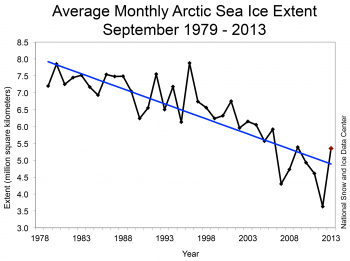Evidence of climate change is especially visible in the Arctic. The loss of Arctic sea ice and the destruction of permafrost not only provide strong evidence that climate change has occurred, they also contribute to further warming.
Arctic Sea Ice Loss
Every year, Arctic sea ice swells in winter and shrinks in summer. It reaches its yearly minimum in September. Since 1979, scientists have been using satellites to measure Arctic sea ice. They’ve found that the yearly September minimum has been decreasing over time, retreating at a rate of more than 13 percent per decade. The rate has worsened after 2007.
 In September 2012, Arctic sea ice shrunk to the smallest area ever recorded since these measurements began. While an increase in sea ice was recorded in September 2013, the minimum for that year was still less than the average minimum for the years between 1981 and 2010.
In September 2012, Arctic sea ice shrunk to the smallest area ever recorded since these measurements began. While an increase in sea ice was recorded in September 2013, the minimum for that year was still less than the average minimum for the years between 1981 and 2010.
The loss of Arctic sea ice could be causing the Earth to warm up even faster. Ice reflects the Sun's heat back to the atmosphere, preventing this heat from being absorbed by the ocean. As the ice shrinks, the ocean absorbs more heat and becomes warmer.
This is one of the reasons that the Arctic is warming at a much faster than regions in the Earth’s middle latitudes are - a phenomenon known as Arctic amplification. In fact, since the middle of the 20th century, temperatures in the Arctic have been increasing twice as fast as temperatures in regions closer to the equator.
The formation of higher waves, enabled by a reduction in sea ice, also contributes to Arctic amplification. With less ice to block wave movement, bigger, higher waves can form, and these waves break the ice up even more. In addition, higher waves speed up shoreline erosion and change the rate at which carbon dioxide is released into the ocean.
The warming of rivers that feed into the Arctic Ocean could also be increasing the rate at which sea ice melts. As watersheds warm, rivers heat up. Once these reach the Arctic Ocean, the rivers release their heat, warming the ocean and melting Arctic ice.
Antarctic sea ice doesn’t have such a strong effect on climate. Since 1979, most Antarctic sea ice has been melting every summer. Energy from the sun is weakest during the Antarctic winter, so the ability of Antarctic ice to reflect this energy is not as important.
Reduction in Permafrost
Permafrost is the bottom layer of soil in the tundra, the biome around the North Pole. Extremely cold temperatures prevent permafrost from ever thawing - it is frozen permanently.
During the summer, soil’s top layer thaws, releasing liquid water. Because permafrost prevents this water from percolating downward, it collects on the surface, creating thousands of lakes. Satellite imagery has shown that over the past two decades, many of these lakes have become smaller or disappeared entirely, a sign that permafrost is thawing and water is draining into the ground. In fact, permafrost is warming even more quickly than the Arctic atmosphere is.
A reduction in permafrost can cause greater amounts of greenhouse gases to be released into the atmosphere. When Arctic vegetation dies, organic matter is stored in permafrost and because of the cold, cannot decompose. When permafrost thaws, organic matter that has been frozen for thousands of years decomposes, releasing the greenhouse gases methane and carbon dioxide into the atmosphere.
Thawing permafrost is prone to erosion, and loss of land caused by thawing can lead to reductions in habitat space for arctic animals, such as caribou, and living space for native communities. Repeated thawing and freezing can damage highways, railroad tracks, airstrips and other forms of infrastructure.
Read more about the consequences of climate change.
References:
16-foot Waves Measured in Arctic Ocean Where There Was Once Only Ice, National Geographic
Arctic Amplification, NASA
Arctic sea ice 101, National Snow and Ice Data Center
Arctic Sea Ice News & Analysis, October 2013, National Snow and Ice Data Center
Arctic sea ice minimum in 2013 is 6th lowest on record, NASA
Is Arctic Permafrost the “Sleeping Giant” of Climate Change?, NASA
Melting Permafrost Causes Coastal Erosion, NASA
Shrinking Arctic Ice Prompts Drastic Change in National Geographic Atlas, National Geographic